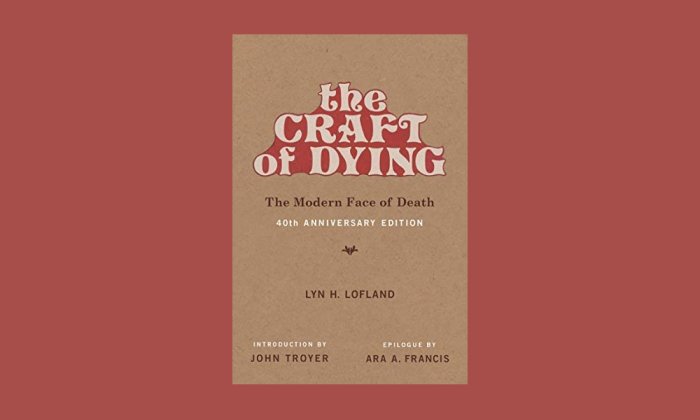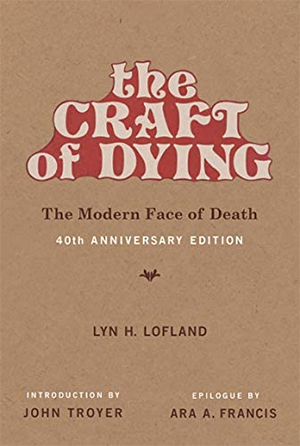The Enduring Genius of ‘The Craft of Dying’

Lyn Lofland’s 1978 book “The Craft of Dying: The Modern Face of Death” completely changed how I think about death and dying. As I write in the introduction to a special 40th-anniversary edition of the book published a few years ago and featured below, “The Craft of Dying” is truly a message in a bottle, one sent from a decade when death and dying social movements coalesced around end-of-life ideologies that the Western world still struggles with today. Sadly, Lyn died this past September after a long and impactful career. I encourage you to read her obituary, written by one of her final graduate students, Ara Francis, who also contributed an epilogue to the book.
Lyn Lofland’s “The Craft of Dying” (1978) is one of the most important books on post-WWII death and dying practices that almost no one has read. To see Lofland’s largely overlooked, but still relevant, text republished by the MIT Press is both thrilling and deeply gratifying. It is the one book that in my capacity as Director of the Centre for Death and Society at the University of Bath I think every person working on contemporary death and dying issues must read. Indeed, I strongly recommend that anyone interested in understanding how events 40 years ago shaped what Lofland would call today’s “thanatological chic” read “The Craft of Dying” and note the current uncanny resemblances to the 1970s.

“The Craft of Dying” is, for me, that death, dying, and end-of-life issues book.
A common response to my adamant recommendation is — why? Why and how is this specific book any different or better than its contemporaries, e.g., “On Death and Dying” by Elisabeth Kübler-Ross or “The Denial of Death” by Ernest Becker (to name two big death canon contenders)? My rapid answer is that Lofland’s book both documents what happened in the 1970s (the formation of new hospice spaces, activist groups encouraging people to accept death, the introduction of college courses on dying, and so on) alongside an invaluable critique of those activities. In fact, it is Lofland’s critique and classification of death-focused groups as social movements creatively constructing a new end-of-life ideology that makes “The Craft of Dying” fundamentally important. Lofland calls these end-of-life groups (similar in structure, she will note, to diffuse 1970s women’s movement and environmental movement groups) the happy death movement and uses the term to connote enthusiastic warriors taking on a challenge. Her critique is both generous and insightful at all times. But Lofland was not content with merely documenting what these death and dying groups did; she wanted to better understand what motivated their new end-of-life politics and thinking. It is her push to clearly articulate what is happening in her own moment that makes her book so valuable today; almost every argument and observation she first presented 40 years ago remains both pertinent and urgently needed now.
Almost every argument and observation Lofland first presented 40 years ago remains both pertinent and urgently needed now.
This book is truly a message in a bottle, and one sent from a decade when death and dying social movements coalesced around end-of-life ideologies that the Western world still struggles with today. That Lyn Lofland accomplished this feat in so few pages is an achievement in and of itself.
Discovering “The Craft of Dying”
For all my praise of Lofland’s work, I am embarrassed to say that I first learned of, and then read, “The Craft of Dying” in summer 2014. My mid-career discovery of Lofland occurred only after my esteemed colleague (and walking Death Studies encyclopedia) Tony Walter asked if I knew her book and the happy death movement argument. I said that no, I didn’t. Tony asked about Lofland, because he understood how “The Craft of Dying” directly related to my (then new) research project on American death and dying discourse during the 1970s.
In a nutshell, this research project examines how the 1970s functioned as a crucial but largely forgotten decade for understanding what motivates today’s death and dying groups, as well as foreshadowing many current end-of-life debates. It is during the 1970s that new death and dying tools and technologies took root, altering the definition of death: things taken for granted today, such as living wills and life-support technologies. Much of the decade’s activity is at a very local level and includes individuals forming groups that emphasize Death Acceptance, the Right-to-Die, and dying a Natural Death — all thoroughly documented in the book.
But the 1970s was also a decade when end-of-life issues extended all the way to the White House and bookended politically tumultuous times. In 1971 President Richard Nixon announced his War on Cancer, and in 1979 President Jimmy Carter formed the President’s Commission for the Study of Ethical Problems in Medicine and Biomedical Behavioral Research, which later published its landmark 1981 report Defining Death: A Report on the Medical, Legal, and Ethical Issues in the Determination of Death during the Reagan administration. Carter’s group would eventually become known as the President’s Council on Bioethics and advise all future Presidents on a wide array of issues, including, but not limited to, death and dying.
Lofland’s research remains a key historical and conceptual anchor for anyone interested in that decade, since “The Craft of Dying” analyzed and critiqued what was happening in the 1970s, during the 1970s. What any reader comes away with from this book, I think, is how death and dying were national conversations related to ongoing events — e.g., the Karen Ann Quinlan right-to-die case in New Jersey (which also went global) — and connected to personal freedoms — e.g., the country’s first Natural Death Act, passed in California in 1976, that gave individuals the right to legally refuse medical treatments even if the refusal meant dying.
After Tony Walter’s helpful nudge, I discovered that “The Craft of Dying” was long out of print (the republishing idea first occurred in this very moment), but I persisted in locating a copy and subsequently devoured the book in one August 2014 sitting. I say in all seriousness that reading this book fundamentally changed how I approached all research on death, dying, the dead body, end-of-life concerns, the politics of death, the historical formation of hospice spaces, current Happy Death groups pushing for what Lofland has called “death talk,” and neoliberal economic “choice” about funerals. I could go on and on. And like any convert with a newly discovered evangelical zeal I wanted nothing more than to excitedly read long sections of “The Craft of Dying” to audiences.
Coincidentally enough, captive audiences were available to me in August 2014, since I was the Scholar in Residence at the Morbid Anatomy Museum in Brooklyn, New York (now sadly closed). I am not kidding when I say that almost all my public lectures during the residency involved me simply reading sections fromLyn’s book, especially the introduction:
It seems likely that eventually humans will construct for themselves a new, or at least altered, death culture and organization—a new “craft of dying”—better able to contain the new experience. I believe, as do other sociological observers … that in the ferment of activity relative to death and dying during the last two decades in the United States we have witnessed and are witnessing just such a reconstruction. Undoubtedly within this ferment, especially that emanating from the mass media, there are elements of fad and fashion—a thanatological “chic” as it were, having approximately the same level of import as organic gardening and home canning among the rich. And certainly one can never underestimate the capacity of American public discourse to transform “life and death matters” into passing enthusiasms. But there is, I believe, more to this activity than simply one more example of impermanent trendiness in modern life. Americans, especially affluent middle-class Americans, have been in the process of creating new or at least altered ways of thinking, believing, feeling, and acting about death and dying because they have been confronting a new “face of death.”
And if you are reading this now and thinking to yourself that these words eerily describe death and dying in your own historical moment (“fad and fashion” always gives me pause), then you begin to see why a book published in 1978 continues challenging everyone to examine how any decade’s happy death movements can possibly be unique, or new, or revolutionary. Lofland wants readers to understand the history of the present, so that the next generation’s death and dying activists might also comprehend the historical relationships to their own current struggle.
Relevance for Today
“The Craft of Dying” also productively intervenes in one of the 1970s’ most unhelpful and unnecessary death and dying arguments, an argument that dogmatically persists today — i.e., that death is a taboo. If the happy death movement functioned like a true social movement, Lyn Lofland reasoned, then that movement needed an enemy, and the death taboo is the perfect foil, since everybody already “knows” that it “exists.”
The fact that we all eventually die becomes that rare universal constant that allows each human the opportunity, should we take it, to experience and think about death and dying in new ways.
Lofland is neither the first author, nor will she be the last, to thoroughly challenge how and why the death taboo argument is used, abused, and greatly exaggerated. The death taboo will always be a productive fiction for various happy death movement groups committed to ideologically transforming the “face of death” in America and the West, but it is a fiction all the same. As she rightly points out in part III, the death taboo argument serves a useful function that is especially popular with death-movement intellectuals (full disclosure: I am a card-carrying member of said group). Her critique of death-movement intellectuals is reason enough to appreciate how farsighted this text remains today. Lofland’s crucial intervention begins:
It has been variously formulated, but essentially the view holds that America is a death-denying society, that death is a taboo topic, that death makes Americans uncomfortable so they run from it, that death is hidden in America because Americans deny it, and so forth. The consequences of all this denial and repression are asserted to be quite terrible: exorbitant funeral costs and barbaric funeral practices, inhumane handling of dying in hospitals, ostracism of the dying from the living, inauthentic communication with the fatally ill, an unrealistic, mechanical, non-organic view of life, and so forth. … As many scholars have pointed out, the empirical evidence for all these assertions is something less than overwhelming (see, for example, Dumont and Foss, 1972; Donaldson, 1972). And one might consider it somewhat odd that the statement that death is a taboo topic in America should continue to be asserted in the face of nearly a decade of non-stop talking on the subject. But if one appreciates the functions these statements serve in enemy evocation, one can also appreciate that their questionable empirical basis is hardly a serious obstacle to endless repetition. The importance of the “conventional view of death”—of the conventional wisdom about death—as propounded over and over again by movement intellectuals, is not its “truth” but its utility.
If making more people rigorously question whether or not they really need the death taboo fiction to advance their own death and dying arguments is the only thing republishing “The Craft of Dying” accomplishes, then all the waiting was worth it. Seeing the taboo argument finally debunked would also recognize Lofland’s scholarly commitment to status quo challenging scholarship both then and now. That said, I have a strong hunch that in the decades to come many death-movement intellectuals and practitioners will still make the death taboo argument to advance both their careers and book sales — a point not lost on Lofland when she states that the death taboo is always about utility, not truth.
Above and beyond the book’s uncanny timeliness (e.g., when reading the preface, replace all the originally listed years with the current year and note the similarities) Lofland taps into another core human experience: we Homo sapiens persist at dying. The fact that we all eventually die becomes that rare universal constant that allows each human the opportunity, should we take it, to experience and think about death and dying in new ways. Part II, Individual Constructions: Styling and Controlling the Dying Role, in particular, focuses on how the dying person becomes something different during the 1970s.
I found myself directly confronting Lofland’s newly articulated experience of death and dying, as discussed in part II, when my younger sister, Julie Troyer, died from terminal brain cancer on July 29, 2018. Watching my sister die made me reflect quite heavily on the book’s key assertions, and in very unexpected ways that accidentally (albeit sadly) coincided with writing this introduction. The MIT Press expressed interest in republishing “The Craft of Dying” while my sister was dying, but I started writing the introduction after she was dead — an interval of approximately one month. My father, Ron Troyer, a long-time grief and bereavement support-group facilitator and retired American Funeral Director, best summed up my death interval experience in very Loflandian language: it is one thing to publicly say, “Julie is dying,” it’s an entirely different experience to state, “Julie is dead.” The former felt active, the latter inert.
I chose to add this section about my recent experience with death and dying, as Lofland rigorously analyzes the role of language and expressivity in encouraging people to discuss precisely these issues. For many days I wondered aloud if it was appropriate for a death studies academic, such as myself, to write a new introduction for “The Craft of Dying” that includes a discussion of such a personal experience. After staring at this book for what seemed like eons, I fully realized the genius of Lyn Lofland’s irreplaceable contribution to contemporary death and dying discourse: that, no matter what any of us do; no matter our personal, professional, or familial relationship with death, everyone still dies. And that Lofland’s always-new-craft-of-dying requires we living humans to critically reflect on these confrontations with mortality in our own meaningful ways, so that we might glimpse, for a moment, what living and dying can become in our technologically advanced 21st century. It is vitally important, I think Lofland would say, to see our personal mortal ends in the modern face of death.
What, Then, for the Future of “The Craft of Dying”?
I see no reason why this book will not remain relevant for another forty years. In surveying how Lyn Lofland’s central arguments evolved over time, connections clearly emerge with the ACT-UP AIDS protests of the 1980s and 1990s, and the contemporary activism of today’s Black Lives Matter groups. Lofland rightly predicts that death and dying social movements will persist at emerging and folding back into each other, precisely because death refuses to phenomenologically disappear. The complexity of what she wrote has never dissipated and will continue to find new audiences for many years to come. Part I, The Situation of Modern Dying: Problems and Potentials, sums up via the chapter title itself what each generation will assuredly confront.
“The Craft of Dying” does come with a cautionary note, however, and it is a point that bears mentioning in the conclusion to this new introduction.
Happy death movement groups (then and now) always run the risk of alienating the very people they so eagerly want to help through non-stop ultra-upbeat expressive death talking that then demands transforming and accepting death/dying/mortality at all costs. The challenge here involves individuals becoming convinced that they are doing death wrong, and in that moment of doubt, Lofland wryly suggests, a “dismal death” movement might emerge:
If expressivity comes to be widely accepted as the only way to achieve a decent death, the emotionally reticent will find themselves under great pressure to “share.” If the idea that death and dying provide new opportunities for self-improvement becomes common currency, the chronic under achiever will find himself facing one more opportunity for failure. Not “getting off” on death may become as déclassé as sexual unresponsiveness. Then perhaps, a “dismal death” movement will rise to wipe the smile from the face of death and restore the “Grim Reaper” to his historic place of honor.
This book will remain relevant for all these specific cautionary reasons, and many more. I hope that in another four decades “The Craft of Dying” is republished for that historical moment’s own happy death movements; especially the ones that still evoke the death taboo enemy in order to evangelize a getting-off-on-death gospel. The irony, of course, is that Lyn Lofland showed us all how easy it is to talk about death and dying without ever transgressing any taboos, and she did this forty years ago in the book that you are about to read.
On further reflection it becomes clear that most happy death movements just can’t help themselves when it comes to constantly talking about this taboo that isn’t actually true. Why? It makes them feel useful. Lyn Lofland would likely say that’s okay.
In the face of dying, Death doesn’t really care.
John Troyer is director of the Centre for Death and Society at the University of Bath and author of “Technologies of the Human Corpse.”



